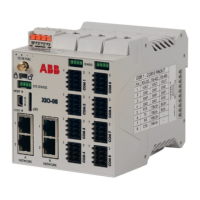190 | XIO USER MANUAL | 2106424MNAA
– When both the RMC and XIOs are in switched mode, the RMC and the XIOs need unique IP addresses
with the same subnet as the single network segment resulting from this mode.
– When the RMC is not in 2-port switch mode, the RMC requires two IP addresses for each of its
Ethernet Interfaces. One for the connection upstream to the local network switch or to the corporate
network. The other for the connection to the XIOs. In this case, the RMC IP address must have the
same subnet as the network it connects to for communication with the XIO.
– When XIOs are not in 4-port switch mode, the XIO IP address configuration depends on how the
interfaces are configured and what network segment is used to connect both the RMC and the XIO.
Unless routers are installed in the field network, traffic between different subnets is not possible. Plan
your field network topology carefully.
Table 10-5: Required connections for XIO – RMC communication
(RMC)
RMC IP to XIO IP/Read TCP
port
be on same network.
RMC IP to XIO IP/Write TCP
port
be on same network.
Application Instance
Passthrough instance
Instance TCP port
be on same network.
10.5 Enterprise and industrial (3-network) support
The 4 Ethernet interfaces on the XIO can support separate networks in two sets: The Enterprise Network
ports (port A1 and port A2) and Industrial Network ports (port B1 and port B2). Each of these sets can be
configured independently of the other to provide additional connection and topology options in the field.
Separate configuration options for these ports become available only when
-port switch mode is disabled.
The Enterprise port set supports both 1-Network and 2-Network modes. The Industrial port set supports
only 2-Network mode. For this scenario, the Enterprise Network set is left on 1-Network mode.
Table 10-6 summarizes the configuration options for this scenario. The Enterprise Network ports can be
used for device management connections (connections supporting remote or local host access) and the
industrial ports can be used for application and measurement data traffic (supporting device-to-device
communication flows). This scenario supports complex applications with several XIOs and where there is
need to isolate XIOs in separate subnets or domains within in the field. Consult with ABB Technical
Support for more details.
Table 10-6: Enterprise and industrial networks - configuration
interface
configuration
Networks
addresses
1 Network
Enterprise ports
One per interface (A1+A2)
2 Networks
Industrial port
One per port: (B1 I P, B2 IP)

